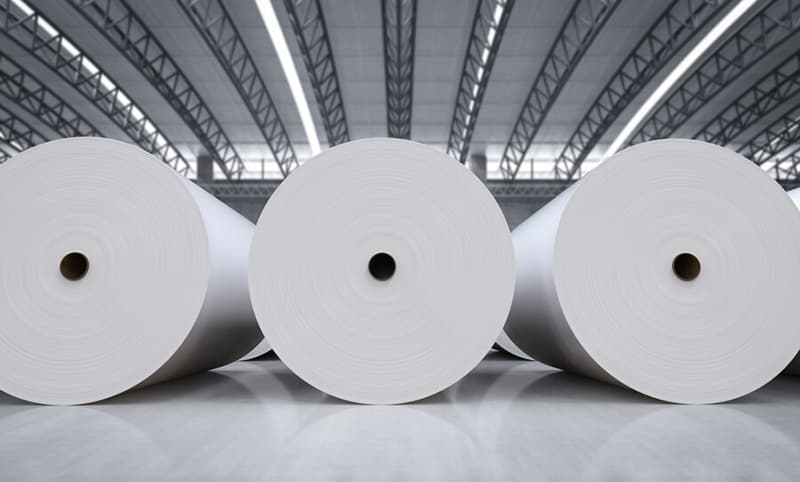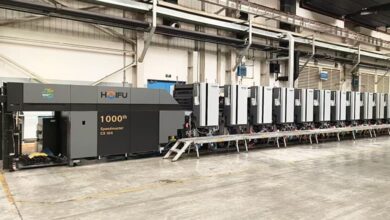“Demand for Printing is Back to Pre-Pandemic Levels”

Exclusive interview with Prof. Kamal Chopra
ME Printer caught up with Prof. Kamal Chopra, President of World Print & Communication Forum (WPCF) and Chairman of International Relations of the All-India Federation of Master Printers (AIFMP), the apex body of the Indian printing industry, in the midst of his busy schedule.
In an exclusive interview, Prof. Chopra talks about the role of WPCF, the problems related to supply chains and paper shortage, global printing at large, the impact of the Ukraine crisis on the printing industry, sustainability in printing, the future of packaging, and much more.
As President of WPCF and Chairman of International Relations of the All India Federation of Master Printers (AIFMP), how do you see the state of the graphic arts industry considering all that is happening in the world at the moment?
Print is an essential and important part of our daily life. Many citizens rely on printed information. Apart from being a large sector of our own, our industry and our products support citizens, culture and all other economic branches in one way or the other. This support is endangered by the current tensions in the supply chain. The printing industry supports all economic activities with their products, be it for information, news, entertainment, education, advertising, or packaging. Print plays a huge role in everyday life – so much so that it is frequently overlooked. Our sector supplies the packaging for goods at supermarkets; the books, newspapers and magazines we read; as well as boxes for our digitally ordered food, clothing, gadgets, and much more.
While during the past two years printed products have clearly witnessed a decline, demand is now coming back to pre-pandemic levels. The demand has surged due to “the economy being back on track” and the education sector opening up. Market stress is on an increase with the war in Ukraine and this will cause additional problems in the supply of forest-based products that chiefly source their wood or pulp from Russia or Ukraine.
Do you think the problem of supply chain and shortages of paper will persist for the foreseeable future? If so, what is your advice for printers to face these challenges?
With less availability of paper or availability at higher cost, the inability to print due to these reasons will cause large financial losses not only to the printing company, but also to the end user, viz. the customer. This will entail foreseeable shortages of many printed consumer goods and some products including food and medical supplies that cannot be put on the market shelf due to a lack of packaging.

Print as an industry is uniquely threatened by the supply chain issue as it relates especially to the paper shortage. It is felt that by the beginning of Q3 of the year 2022, things may start improving as far as availability is concerned, but I am not quite sure if the prices will also come down to the level seen in 2020.
The only thing printers can do is to adapt to the change and try to include Internet in printing. Since ink on paper is not sufficient, printers will have to think about new innovative uses of printing. Reduction of wastage and shrinking the cost of production is the only solution for survival. One has to make sure of a backup supplier in case of an unexpected event that could disrupt the supply chain, since geopolitical issues may sometimes quickly change the status quo. The good news is that although there may be some price increases in the next six months for all types of paper because of the underlying cost of pulp, analysts expect prices to stabilize next year.
Is WPCF offering printers and its member’s guidelines on how to mitigate the damages of the adverse effects of the current disruption in supply chain and other crises such as war in Ukraine?
At WPCF we are constantly guiding the member associations through the current situation and providing possible solutions. Recently a worldwide press release was also issued on the current subject. It is customary to share data regarding economic indications of the printing and packaging industry, so that the printers can plan their future in a better way.
You are active, both, in the global printing industry and the Indian printing industry. How does printing industry in India compare to the rest of the world, especially the West?
With a total of 2,50,000 printers, India has the largest number of printing companies in the world. Printing industry is not only one of the biggest, but also one of the fastest growing sectors, with a capital investment of over $2 billion.
The quality standards have improved dramatically and immense capacities have been created. Some printers have won recognition by winning prizes at international competitions for the excellence in printing. The current annual turnover of the printing industry (except packaging printing) is estimated to be around INR 1.10 lakh crore. The turnover of packaging printing including labels is more than INR 1.5 lakh crore. Combining both, the value of the printing market in India is more than INR 2.60 lakh crore (2020 figures).
Does WPCF publish major studies regarding printing industry and conduct surveys? In general, what is the role of WPCF?
The World Print & Communication Forum is a collaborative platform for the world’s major transnational and national printing associations to work together to promote the development and prosperity of the global printing industry. WPCF also facilitates and encourages communication with other parts of the print value chain to further develop the print and communication market through international and cross-industry collaboration and knowledge-sharing. Studies done by various forums and countries are discussed during WPCF board meetings and circulated to the members and other printers’ associations worldwide.
The objectives and purpose of WPCF are: a) to promote the development and prosperity of the printing, graphic arts, communication and allied industries in all regions of the world, b) to improve the management of these industries with a view of continuing and increasing their growth, and c) to provide a platform for exchange of information and cooperation between users and suppliers of technology and services and to jointly promote and develop other related activities.
Sustainability is not a buzzword anymore and many government agencies and legislators around the world are introducing laws for protection of the environment. In your opinion how can printers be more sustainable?
The forces shaping today’s print industry and its sustainability are complex and often confusing for printers and their customers. Factors include electronic media, technological innovation, cross media business models, environmental regulations, global economics, and an increasingly mobile and interactive media audience. Printers are reshaping their businesses to help clients leverage channels and align commercial and environmental goals.
Printers must be able to deliver their products within a cohesive environmental framework and at the same time be profitable. Development of sustainability policies and production models is a massive challenge for print media supply chains.
In 2020, the global commercial printing had a value of around $400 billion and based on some estimates it will exceed $470 billion by 2026. Do you agree with these estimates, and considering the many crises that we are experiencing today, are these figures achievable?
According to the Mordor Intelligence survey, the Global Commercial Printing Market was valued at $411.99 billion in 2020, and projected to be worth $472.35 billion by 2026, registering a CAGR of 2.24% during the period 2021-26. As per the report, the commercial printing market is poised for a remarkable growth over the next five years.
Nowadays, it’s seen as short-run jobs, be it books, direct mails, brochures, and catalogues that are increasing. Many companies are returning to direct mails, and I do feel that a maximum number of corporates will utilize direct mail campaigns in future. On the other hand, increased demand for promotional materials from the retail, food, and beverage industries is driving the market. I do feel the silver lining and hope for a substantial growth in the commercial printing sector also.
In your opinion how does the decline in publication jobs reflect in the market aimed at substrates? Do you believe the falling volumes of newsprint will be permanent and what is your take on the Indian market where the demand for the printed newspaper is still very high?
Newspapers in terms of volume are shrinking in India too, though there is demand for printed newspaper. India is witnessing a spurt in city editions of newspapers with local news which are beginning to compensate the volume loss.
Falling volumes can also be compensated by including artificial intelligence (AI) and augmented reality (AR) applications. The future newspaper may be combination of QR, AI, and AR, where we will not only read but also see the ‘live’ newspaper.
Do you think the rise of online print order and platform economy and e-commerce are favourable for the development of the printing industry?
With e-commerce skyrocketing in popularity, the need for cardboard and other packaging materials continues to spiral upward. In this scenario the online platform is another boost for the print packaging industry. As far as the web to print is concerned, it is definitely a wonderful opportunity, especially for the micro and small printers. On the other hand it also acts as a tool to reduce the transport cost, especially in the wake of soaring petroleum costs.
Packaging is a new star, especially in the wake of the COVID-19 pandemic crisis. In this scenario are there any printers who want to experiment with packaging, since publication printing is not profitable anymore?
With commercial printing on the wane, growing demand for packaging is rising disproportionately fast in threshold countries. According to the Indian Institute of Packaging (IIP), packaging consumption in India increased 200% in the past decade; from 4.3 kgs per person per annum (pppa) to 8.6 kgs pppa.The Indian packaging industry is growing very fast. It has a commercial influence on all other industries directly or indirectly. According to the industry experts, the annual turnover of the Indian packaging industry will touch $32 billion by 2025 from the present $24.6 billion.The Brazilian Institute for Economics has also published current figures for the packaging industry in this South American country.
The global packaging market is estimated to total $424 billion with an annual growth rate of some 3.5%. Europe accounts for $127 billion (30%), North America for $118 billion (28%), Asia for $114 (27%), Central America for $30 billion (7%) and other countries for $30 billion (8%).The industry is expected to reach $204.81 billion by 2025 from $50.5 billion in 2019 at a growth rate of 26.7% annually. The e-commerce segment of the packaging market was estimated at $451.4 million in 2019 and is forecast to reach $975.4 million by 2025 at 13.8% annually.
The annual growth rate of this sector is about 15% per annum. As per the McKinsey report, the middle-class population will be ten times by 2025 in India. It will further trigger the consumption of packaging material.
Thus, it can be concluded that the packaging industry will grow further. The packaging industry in threshold countries is the most attractive emerging market for investment.





